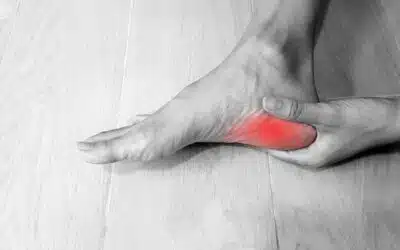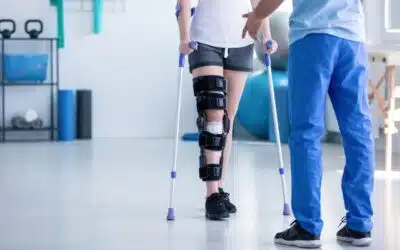Definition of Chronic Pain: Chronic pain is typically defined as pain that persists beyond the normal healing time, usually considered to be three months or more. Unlike acute pain, which signals an injury or a specific problem that needs immediate attention, chronic pain can last for months, years, or even a lifetime. It can be continuous or intermittent, mild or severe, and it might originate from an initial injury or infection, or there might be an ongoing cause such as illness. However, there can also be no clear cause.
Prevalence and Impact of Chronic Pain on Daily Life: Chronic pain is a significant public health issue. According to the World Health Organization, one in five people globally suffers from chronic pain. It affects more individuals than diabetes, heart disease, and cancer combined. The impact of chronic pain on an individual’s daily life can be profound. It can lead to reduced mobility, a decline in the ability to perform daily tasks, lost workdays, and a decreased quality of life. Additionally, chronic pain can have psychological effects, leading to conditions like depression, anxiety, and sleep disturbances.
The Role of Physiotherapy in Managing Chronic Pain: Physiotherapy, also known as physical therapy, plays a pivotal role in managing chronic pain. It offers a non-invasive and drug-free approach to pain relief and functional improvement. Physiotherapists use a range of techniques to improve mobility, strengthen muscles, and promote overall well-being. Their interventions aim not only to alleviate pain but also to address its root cause, ensuring a long-term solution. By educating patients about their conditions and providing them with tools and strategies, physiotherapists empower individuals to take an active role in their pain management journey.
Understanding Chronic Pain
Difference Between Acute and Chronic Pain: Acute pain is a direct response to a specific injury or disease, acting as the body’s alarm system. It usually has a clear source, is of short duration, and typically resolves as the underlying cause heals. Examples include a sprained ankle or pain after surgery. On the other hand, chronic pain persists long after the initial injury or disease has healed, often lasting for three months or longer. It can be the result of an ongoing condition, like arthritis, or it can have no discernible cause, making it particularly challenging to treat.
Common Causes of Chronic Pain: Chronic pain can arise from various conditions and factors. Some of the most common causes include:
- Osteoarthritis: A degenerative joint disease where the protective cartilage wears down.
- Rheumatoid Arthritis: An autoimmune disorder that targets the lining of joints.
- Fibromyalgia: A condition characterized by widespread musculoskeletal pain.
- Neuropathic Pain: Pain resulting from damage to the nervous system, such as diabetic neuropathy or post-herpetic neuralgia.
- Chronic Back Pain: Often due to issues like herniated discs, spinal stenosis, or muscle strain.
- Migraines and Chronic Headaches: Recurring head pain that can be debilitating.
- Cancer: Pain can arise from the disease itself or as a side effect of treatments like chemotherapy.
- Post-surgical Pain: Persistent pain after undergoing a surgical procedure.
The Physiological and Psychological Components of Chronic Pain: Chronic pain is not just a physical sensation; it encompasses both physiological and psychological components. Physiologically, chronic pain can result from nerve damage, inflammation, or other bodily dysfunctions. Over time, the nervous system can become more sensitive, causing pain even in the absence of a stimulus. Psychologically, chronic pain can lead to feelings of frustration, hopelessness, anxiety, and depression. The emotional toll of chronic pain can, in turn, exacerbate the physical pain, creating a vicious cycle. Recognizing the interplay between the mind and body is crucial for effective pain management.

Physiotherapy: A Comprehensive Approach to Pain Management
Principles of Physiotherapy: Physiotherapy, often referred to as physical therapy, is grounded in understanding how the body moves and functions. The primary principles include:
- Assessment: A thorough evaluation of the patient’s physical condition, movement capabilities, and pain levels.
- Individualized Treatment: Tailoring interventions to meet each patient’s unique needs and goals.
- Education: Empowering patients with knowledge about their condition and the importance of active participation in their recovery.
- Prevention: Offering guidance on how to avoid future injuries or pain flare-ups.
How Physiotherapy Differs from Other Pain Management Techniques: While there are various methods to manage pain, physiotherapy stands out for several reasons:
- Non-invasive: Physiotherapy techniques do not require surgical intervention or invasive procedures.
- Drug-free: While medications can be essential to pain management, physiotherapy offers solutions that don’t rely on pharmaceuticals, reducing the risk of side effects or dependency.
- Functional Improvement: Beyond just pain relief, physiotherapy aims to restore and enhance the patient’s ability to perform daily activities and improve their quality of life.
The Importance of a Patient-Centered Approach: A cornerstone of physiotherapy is its patient-centred ethos. This means:
- Active Participation: Patients are encouraged to be active participants in their treatment, setting goals and providing feedback throughout the process.
- Collaborative Decision Making: Therapists work alongside patients, making decisions based on the patient’s preferences, needs, and values.
- Empowerment: By equipping patients with the tools, exercises, and knowledge they need, physiotherapy empowers individuals to take control of their pain and overall health.
- Building Trust: A strong therapist-patient relationship is vital. Trust and open communication ensure the treatment is effective and tailored to the individual’s needs.
Common Physiotherapy Techniques for Chronic Pain
Manual Therapies:
- Massage: This involves manipulating soft tissues to relieve muscle tension, improve circulation, and promote relaxation. It can be particularly beneficial for conditions like fibromyalgia or muscle strain.
- Mobilization: A gentler form of manipulation, it involves slow, measured movements to stretch tight joint tissues and improve flexibility.
- Manipulation: This is a more forceful technique where the therapist applies a rapid thrust to a joint. It can help relieve pain and improve joint function, especially in conditions like chronic back pain.

Exercise Therapy:
- Strengthening Exercises: These focus on building muscle strength, which can provide better support to joints and reduce pain. For instance, knee pain from osteoarthritis can benefit from strengthening the muscles around the knee.
- Flexibility Exercises: Stretching routines that aim to improve the range of motion in joints and reduce muscle stiffness. Regular flexibility exercises can help manage conditions like rheumatoid arthritis.
- Aerobic Exercises: Low-impact activities like walking, swimming, or cycling can improve cardiovascular health, boost mood, and reduce pain. They’re especially beneficial for overall pain management and improving endurance.
- TENS (Transcutaneous Electrical Nerve Stimulation): A device that delivers small electrical pulses to the body, which can help block pain signals and stimulate endorphin production, the body’s natural painkillers.
- Ultrasound: This therapy uses sound waves to produce heat within body tissues, promoting healing and reducing pain. It’s often used for conditions like tendonitis or bursitis.
- Laser Therapy: Low-level lasers can help reduce inflammation, promote healing, and alleviate pain. It’s a non-invasive treatment option for various chronic pain conditions.
Mind-Body Techniques:
- Relaxation: Techniques such as progressive muscle relaxation or deep breathing exercises can help reduce muscle tension and alleviate pain.
- Breathing Exercises: Controlled breathing can help manage pain and reduce anxiety associated with chronic pain conditions.
- Guided Imagery: This involves visualizing peaceful and pain-free scenarios, which can help divert attention from pain and promote relaxation.
Benefits of Physiotherapy for Chronic Pain
Reduction in Pain Intensity: Physiotherapy offers a range of techniques, from manual therapies to electrotherapy, that directly target pain sources. Physiotherapy can significantly reduce pain levels by addressing the root causes of pain, such as muscle imbalances or joint dysfunctions, allowing patients to engage more fully in daily activities without discomfort.
Improved Mobility and Function: One of the primary goals of physiotherapy is to restore functional movement. Chronic pain often leads to reduced mobility, making simple tasks challenging. Through targeted exercises and therapies, physiotherapists help patients regain strength, flexibility, and coordination, enabling them to move more freely and confidently.
Decreased Reliance on Pain Medications: While medications can be effective in managing pain, they often come with side effects and the potential for dependency. Physiotherapy offers non-pharmacological interventions that can reduce or even eliminate the need for pain medications. By treating the underlying causes of pain and providing patients with tools to manage discomfort, many individuals find they can reduce their medication dosage or stop taking them altogether.
Enhanced Quality of Life and Mental Well-being: Chronic pain doesn’t just affect the body; it also takes a toll on the mind. The constant discomfort can lead to feelings of frustration, depression, and anxiety. Physiotherapy, especially when combined with mind-body techniques, can improve mental well-being. As pain decreases and mobility improves, patients often experience a boost in mood, a renewed sense of hope, and an overall improved quality of life.
Empowerment and Self-management: A unique aspect of physiotherapy is its emphasis on patient education and empowerment. Physiotherapists equip patients with knowledge about their condition and teach them exercises and strategies to manage pain independently. This sense of control and active involvement in their own recovery can be incredibly empowering for individuals, giving them the confidence to face challenges and actively work towards better health.

Case Studies: Real-world Outcomes
Patient A: Chronic Back Pain Post-Injury
Background: John, a 45-year-old construction worker, suffered a fall at work, leading to a herniated disc in his lower back. Despite undergoing surgery, he continued to experience persistent pain, making it difficult for him to return to work or even perform daily tasks.
Physiotherapy Approach: John’s physiotherapist designed a program that combined manual therapies to alleviate muscle tension, strengthening exercises to support his spine, and posture education to prevent further strain. Electrotherapy, specifically TENS, was also introduced to manage pain flare-ups.
Outcome: After several months of consistent therapy, John reported a significant reduction in pain. He was able to return to work on light duties and gradually resumed his regular activities, including playing with his children, without discomfort.
Patient B: Fibromyalgia and Widespread Muscle Pain
Background: Maria, a 32-year-old teacher, was diagnosed with fibromyalgia after years of unexplained muscle pain, fatigue, and sleep disturbances.
Physiotherapy Approach: Given the nature of fibromyalgia, Maria’s treatment focused on a combination of gentle aerobic exercises, like swimming, to boost her energy levels and improve sleep. She also received soft tissue massages to alleviate muscle pain and was taught relaxation techniques to manage stress, a known trigger for fibromyalgia flare-ups.
Outcome: While fibromyalgia is a chronic condition with no cure, Maria found that regular physiotherapy sessions helped manage her symptoms. She reported better sleep, reduced pain levels, and an improved ability to handle the demands of her job.
Patient C: Osteoarthritis and Joint Pain
Background: Raj, a 68-year-old retired engineer, began experiencing pain and stiffness in his knees, which was later diagnosed as osteoarthritis. The condition made it challenging for him to enjoy his passion for gardening and walking.
Physiotherapy Approach: Raj’s treatment plan emphasized strengthening exercises to support the affected joints and flexibility exercises to maintain joint mobility. He was also introduced to hydrotherapy, where exercises are performed in a pool, reducing the impact on his knees while providing resistance.
Outcome: With consistent physiotherapy, Raj noticed a marked improvement in his knee function. He was able to resume gardening and even participated in a local walking group, activities he thought he’d have to give up due to his condition.
These case studies provide real-world examples of how physiotherapy can make a tangible difference in the lives of individuals with chronic pain. They illustrate the versatility of physiotherapy techniques and the potential for improved quality of life, even in the face of persistent pain conditions.
Challenges and Limitations
Need for Consistent Therapy Sessions: Physiotherapy often requires a commitment to regular sessions to achieve the best outcomes. Missing appointments or not adhering to prescribed home exercises can slow down progress. Maintaining consistent therapy can be challenging for some patients, especially those with busy schedules or limited access to transportation.
Individual Variability in Response to Treatment: Just as every individual is unique, so is their response to physiotherapy. What works wonders for one patient might not be as effective for another. Factors such as age, overall health, the severity of the condition, and even genetics can influence how a person responds to treatment.
Potential Temporary Increase in Pain Post-Treatment: Some physiotherapy interventions, especially certain manual therapies or exercises, can lead to temporary soreness or an increase in pain. While this is often a normal part of the healing process, it can be discouraging for patients, especially if they’re not prepared for it.
Limitations in Severe Cases: While physiotherapy can be incredibly beneficial for a wide range of chronic pain conditions, there are instances where its scope is limited. In severe cases of degeneration, injury, or other medical conditions, physiotherapy might offer only partial relief, and other medical interventions could be necessary.
Psychological Barriers to Recovery: Chronic pain often comes with psychological challenges, including depression, anxiety, and fear of movement (kinesiophobia). These psychological factors can hinder the effectiveness of physiotherapy treatments. Addressing these barriers often requires a multidisciplinary approach, combining physiotherapy with psychological support.
Financial and Accessibility Concerns: Not everyone has easy access to physiotherapy services. Factors like location, insurance coverage, and personal finances can limit an individual’s ability to seek and continue treatment. In some regions, there might be long waiting times to see a physiotherapist, delaying potential relief and recovery.
Conclusion
The Importance of a Multidisciplinary Approach to Chronic Pain Management: Chronic pain is a complex condition that often requires a multifaceted approach for effective management. While physiotherapy plays a pivotal role, it’s most effective when combined with other disciplines, such as medication management, psychological support, and lifestyle modifications. Collaborative care ensures that all aspects of a patient’s well-being are addressed, offering the best chance for improved quality of life.
Encouraging Patients to Participate in Their Recovery Actively: One of the standout features of physiotherapy is its emphasis on patient empowerment. By educating patients about their condition and equipping them with tools and exercises, they become active participants in their recovery journey. This active involvement not only enhances the effectiveness of treatment but also instills a sense of control and hope in patients, which is crucial for managing chronic conditions.
The Promising Role of Physiotherapy in Improving the Lives of Those with Chronic Pain: Despite the challenges and limitations, physiotherapy has consistently shown its value in the realm of chronic pain management. Through evidence-based techniques, personalized care, and a comprehensive approach, physiotherapy offers a beacon of hope for many suffering from persistent pain. As research continues and techniques evolve, the role of physiotherapy in pain management is poised to become even more significant, offering relief and improved quality of life to countless individuals worldwide.
References
Psychologically informed physical therapy for musculoskeletal pain: current approaches, implications, and future directions from recent randomized trials.
- Source: PubMed
- Link to the study
Managing Chronic Neuropathic Pain: Recent Advances and New Challenges.
- Source: NCBI – PMC
- Link to the study
Physical Rehab and Pain Management: A Special Collection Looks at New Approaches.
- Source: APTA (American Physical Therapy Association)
- Link to the article
The role of specialist physiotherapy in a pain management clinic.
- Source: NCBI – PMC
- Link to the study
Books:
Chronic Pain Management for Physical Therapists
- Description: This book is specifically written for physiotherapists and provides practical information for treating patients with chronic pain. It reflects state-of-the-art and current practice in chronic pain management for physical therapists.
- Source: ScienceDirect
Comprehensive Treatment of Chronic Pain by Medical, Interventional, and Integrative Approaches
- Description: This book delves into the clinical aspects of chronic pain management, covering both interventional and noninterventional therapies. It’s a useful resource for chronic pain physicians and primary care givers.
- Source: Amazon






0 Comments